Readers must familiarize themselves with these subtopics to understand the concepts discussed in this chapter. These are linked within this chapter, but it may be easier to read them in advance.
Thrust Vectoring Vanes - revolutionary fighter technology
Double Air Crews - keep aircraft flying
AGM-122 Sidearm - why is this ignored?
Air Burst Bombs - to deal with pursuers
UAV Fighters - the future Red Baron
Theater-Wide Anti-Aircraft Missiles - fire missiles from AWACS and Hawkeye
Surface-to-Air Radar Aiming System - for self-guided missiles
Acoustic Missiles - chase down loud aircraft engines
Air Commandos - infantrymen fighting for air superiority
___________________________________________________________
 Air combat is one area that will change
dramatically because of advances in technology. The F-22 has adjustable nozzles to allow
thrust vectoring, however, a simpler and cheaper method has been developed using Thrust Vectoring Vanes,
which greatly improve fighter maneuverability. These can be attached to any fighter in service today,
which also provides an outstanding short-take off and landing capability.
This is more practical than complex vertical take-off (VTOL) aircraft like
the AV-8B or the new F-35B. VTOL aircraft are more expensive and heavier, which reduces
flight performance.
Air combat is one area that will change
dramatically because of advances in technology. The F-22 has adjustable nozzles to allow
thrust vectoring, however, a simpler and cheaper method has been developed using Thrust Vectoring Vanes,
which greatly improve fighter maneuverability. These can be attached to any fighter in service today,
which also provides an outstanding short-take off and landing capability.
This is more practical than complex vertical take-off (VTOL) aircraft like
the AV-8B or the new F-35B. VTOL aircraft are more expensive and heavier, which reduces
flight performance.
The US Navy conducted successful tests with Germany on the X-31 Extremely Short Take-Off and Landing (ESTOL) concept or over a decade. Coupled with the right flight control software, the thrust vectoring system on the X-31 permits it to fly at up to a 70 degree angle of attack, meaning that its nose can be pointed 70 degrees above the aircraft’s actual direction of flight. The photo above is a modest demonstration; in a 70 degree pitch-up the X-31 can rise up almost on its tail (90 degrees is straight up) and then plop down and stop almost immediately. This also allows a fighter to take-off within a couple hundred feet so catapults nor arresting cables are required for carrier operations. This has been proven many times and can greatly simplify carrier operations, reduce ships crew requirements, and allow ESTOL operations ashore. However, this is unattractive to a US Navy carrier pilot culture fixated with the arcane practice of catching the third wire.
Better Fighter Aircraft
Most fighters have a day and night capability, yet they can't fight around the clock as their pilots and ground crews require sleep. Double Air Crews are the solution, which can nearly double the combat effectiveness of a squadron. The biggest advance in fighter technology this past decade has been tremendous advances in Infrared Search and Track (IRST), which can now track flying objects some 100 miles away. It is a passive system too, while traditional radar is active and can be detected and jammed. However, IRST is degraded by rain, clouds, and fog. While the Americans have better IRST technology, attention has focused on ground attack systems, so the new F-22 has no IRST system. The Russians have focused on IRST aircraft detection and integrated the tracking capability into their air combat software. They have fielded excellent systems that have been exported.
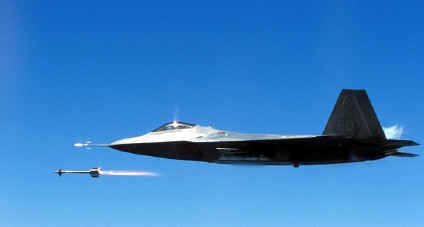 Another
major advance has begun to appear in aircraft equipped with Active
Electronically Scanned Array (AESA)
radar, which are carried by the F-22 (right) and backfitted on
most F-15Cs. This radar provides roughly twice the range and twice
the definition of current radar. This advanced
technology has already been exported with the sale of F-15SGs to
Singapore.
Another
major advance has begun to appear in aircraft equipped with Active
Electronically Scanned Array (AESA)
radar, which are carried by the F-22 (right) and backfitted on
most F-15Cs. This radar provides roughly twice the range and twice
the definition of current radar. This advanced
technology has already been exported with the sale of F-15SGs to
Singapore.
Major advances in miniature cameras and lightweight flat displays now allow major improvements to a fighter pilot's visual awareness. The British tested a "Linda Blair" system that allows a pilot to see in all directions through a video system. These may appear in all fighter cockpits, perhaps with a magnification capability. This will allow a fighter pilot to visually identify aircraft beyond unaided visual range. This is extremely important because of the "fog of war" and with civilian aircraft everywhere, pilots want to confirm a target visually before gunning it down.
The AGM-122 Sidearm was developed as an anti-radiation missile so that helicopters can attack ground-based air defense radars, while larger HARMs have been used for over a decade. Why haven't they been employed in air-to-air combat, especially mounted rear-facing? Air Burst Bombs are another air combat weapon with much potential, especially for slow attack aircraft like the A-10. The Russians developed a rearward fired missile that may become common everywhere.
A similar innovation may involve a tail gun with an infrared targeting system. If a bogey gets on the tail of an aircraft, the pilot can switch on the automatic tail gun while taking evasive maneuvers. In two-seat aircraft, the backseater can fill the World War I role of aiming and firing the tail gun using a video monitor. Since the rounds trail out behind a fast moving jet, they do not need to be fired from a high-powered cannon. The M129 automatic grenade launcher has been used by attack helicopters and spews out 400 40mm rounds a minute. It can also replace the current chaff/flare dispenser systems. The M129 can fire rounds which alternate between chaff, flares, and high-explosive rounds with proximity fuses. Even if the tail gun fails to hit a bogey, the sight of 40mm rounds will discourage pursuit, especially the threat of ingesting debris into jet engines. Tail guns would also prove effective in the suppression of enemy air defense. After an aircraft drops its bomb load and pulls away, an infrared seeking tail gun can engage hot spots below, like AAA guns, missiles, and vehicles.
Directed Energy Weapons
New strike weapons may include electromagnetic pulse weapons that cause a shock wave to destroy sensitive electronics, like computer chips. There is said to be a cruise missile warhead with this capability. Aviation Week reported in 2005 that the Air Force is modifying its new AESA radars to be used as weapons.
AESA radars ... use thousands of small transmitters/receivers, each a couple of inches square, that allow the array to conduct many tasks simultaneously. Those include detection of small, even stealthy targets, tracking and communications... and "jamming"... Possible AESA techniques for attacking another radar could include burning through the target radar's antenna side-lobes, filter side-lobes, or other known features of the target system. Radar specialists suggest it is reasonable to suppose this capability is already available to some fielded systems. [Airborne radar weapon development] appear to be focused on cruise missiles and self-defense against anti-radiation, home-on-jam and air-to-air missiles. The radars seem particularly effective against the latter categories because energy available to focus on the approaching missile increases as an inverse square as distance decreases.
High-Power Microwave (HPM) is also being groomed as energy weapons. They tend to generate ultra-strong bursts across a range of frequencies, for just a few trillionths of a second, whereas AESA zaps targets with longer, more directed blasts. That article notes:
While HPM produces higher peak power, AESA often generates greater average power. That produces different operational and targeting strategies. For example, Raytheon's [HPM-based] airport protection system uses infrared sensors to find the target and determine where to focus its beam. It also produces effects at longer range, possibly as much as 100 miles, because it produces powerful pulses of energy. AESA radar has the built-in ability to find and track a target, so it can be held on the target for the necessary additional microseconds needed to create its weapons effect.
Some HPM pulses are designed to be very broadband, covering "many gigahertz" of frequencies, so they are more likely to find any opening or vulnerability in a target, the radar specialist says. AESA radar has a narrower frequency range, but it uses its radar capability to identify a target, search a library for its vulnerable frequencies and then tailor the signal for the specific target.
These directed energy weapons have been in development for decades, so it is difficult to determine how close they are to reality. One problem is the energy requirement limits their use to seconds. The value of these weapons is unclear, but it seems they can only attack unprotected electronics from less than 1000 meters. Anything shielded in metal or in a bunker will be protected.
Missiles with Wings
During the late 1950s and early 1960s, it was assumed that air-to-air missiles had made dogfighting obsolete. However, air combat in the Middle East and Vietnam showed that fighters could usually outmaneuver pursuing missiles, and that fighter pilots with realistic training and guns ruled the skies. The US military learned that intensive training was the key as sixteen North Vietnamese pilots became aces flying older Soviet fighters, including Nguyen Van Coc, the top ace of the war with nine kills. As a result, research and development was devoted to improving fighter maneuverability and little on improving missiles. In recent years, the USAF became enamored with stealth, devoting nearly all efforts to the F-35 and little to new weaponry.
 While missiles have improved, they lack wings to allow tight turns.
If
missiles had wings, fighters cannot easily lose them. Amazingly, missiles with wings, even small
pop-out
wings like those on Navy Tomahawk missiles, have never been fielded. The AGM-119B Penguin supersonic anti-ship missile (left) has fold out wings that
can be adapted to air-to-air missiles. Winged
missiles change air combat since aircraft are unable to outmaneuver
them. To learn more about the
value of wings, read the excellent book Boyd, an biography about fighter
pilot John Boyd. He changed the thinking of the US Air Force in the 1960s by
proving that bigger wings that provide greater maneuverability are more important to
fighter aircraft than top speed.
While missiles have improved, they lack wings to allow tight turns.
If
missiles had wings, fighters cannot easily lose them. Amazingly, missiles with wings, even small
pop-out
wings like those on Navy Tomahawk missiles, have never been fielded. The AGM-119B Penguin supersonic anti-ship missile (left) has fold out wings that
can be adapted to air-to-air missiles. Winged
missiles change air combat since aircraft are unable to outmaneuver
them. To learn more about the
value of wings, read the excellent book Boyd, an biography about fighter
pilot John Boyd. He changed the thinking of the US Air Force in the 1960s by
proving that bigger wings that provide greater maneuverability are more important to
fighter aircraft than top speed.
Winged missiles will demonstrate the value of jet-powered UAV Fighters, which can turn much tighter than any manned fighter. They may be air-launched by larger aircraft to boost their range and may carry an automatic cannon or missiles. Fighter UAVs may be controlled remotely or operate on a search and destroy mode.
Jumbo Jet Fighters
Old AWACs airborne radar aircraft based on the Boeing 707 passenger jet still rule the skies four decades after they were introduced. Since these can see aircraft up to 200 miles away, why not arm them with Theater-Wide Anti-Aircraft Missiles so they can become jumbo jet fighters? Long-range anti-radar missiles like HARM can be carried to home-in on an enemy fighter's radar emission. Jumbo jet fighters will not become the air superiority weapon, but a quarterback that controls smaller fighters yet can launch weaponry itself for self-defense and at targets of opportunity.
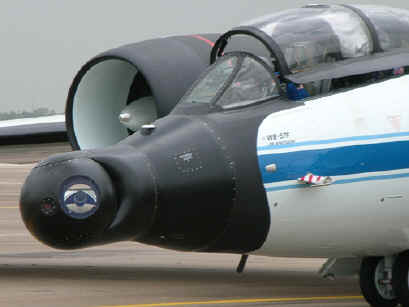 Future jumbo jet fighters are likely to have blister turrets
like those used by World
War II bombers. NASA developed a small blister turret for powerful
video cameras mounted on the nose of old WB-57s. (right) Larger turrets may exist
at locations around future jumbo jet fighters, like World War II bombers. Turrets may
contain an automatic cannon, anti-missile infrared missiles like Stingers, possibly a
blinding laser,
or different types of countermeasures like microwave weapons to fry the
electronics of incoming missiles.
Future jumbo jet fighters are likely to have blister turrets
like those used by World
War II bombers. NASA developed a small blister turret for powerful
video cameras mounted on the nose of old WB-57s. (right) Larger turrets may exist
at locations around future jumbo jet fighters, like World War II bombers. Turrets may
contain an automatic cannon, anti-missile infrared missiles like Stingers, possibly a
blinding laser,
or different types of countermeasures like microwave weapons to fry the
electronics of incoming missiles.
Jumbo jet fighters will be designed with a 360 degree fighting ability, e.g. the ability to fire at targets in any direction. This will be a major departure from the lingering World War I concept of fixed weaponry pointing forward where the pilot must maneuver the aircraft to employ its weapons. Imagine a tank with no turret so the tank driver must maneuver to aim its weapons. That seems absurd, but this World War I concept is still used by modern fighter aircraft. While a turret is too heavy for a fighter, its gun could be designed to "float" several degrees in any direction to provide greater reach, especially if the gun is aimed by the radar system.
Dr. John Stillion conducted a historical analysis of air-to-air combat, drawing on a database of over 1450 air-to-air victories from multiple conflicts from 1965 to 2015. Using this data, Stillion assessed how advances in sensor, weapons, and communication technology have changed air combat and implications for future combat aircraft designs and operational concepts. Stillion concluded that these advances have fundamentally transformed the nature of air combat by reducing the utility of some attributes traditionally associated with fighter aircraft (e.g., extreme speed and maneuverability) while increasing the value of sensor and weapon payload as well as range. As a result, an effective sixth-generation “fighter” may use a modified bomber airframe optimized for the air-to-air mission,
The US Air Force spent billions of dollars for its airborne laser program in which a large laser was mounted in a 747 aircraft. However, the concept of firing a laser beam up to 250 miles though the Earth's atmosphere with enough power to burn though a missile casing was a fantasy because most all of the laser beam is refracted by air particles, even on a clear day. However, the value of an airborne laser for shooting down incoming cruise missiles or aircraft seems promising. Although keeping the laser spot on an exact point of an aircraft may prove impossible, a laser can instantly blind pilots and damage aircraft optical systems from hundreds of miles away. On the other hand, current chemical lasers are bulky and dangerous to operate, yet newer solid state lasers may solve that problem.
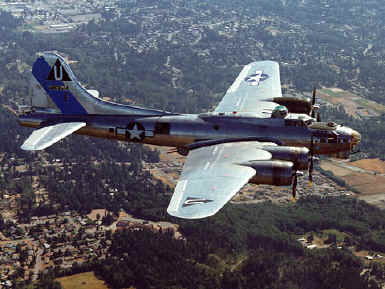 Using large passenger jets for air combat will resurrect the B-17 "flying
fortress" concept of World War II. Aircraft will not try to outmaneuver and evade
incoming threats like enemy fighters and surface-to-air missiles, it will gun
them down. This may seem ambitious, but remember that is the strategy of
ships in a navy fleet and their speed and maneuverability is far less than a
passenger
jet. Risking a big passenger jet may seem impractical, but
remember that a Boeing 737 with weapons costs less than an F-22.
Using large passenger jets for air combat will resurrect the B-17 "flying
fortress" concept of World War II. Aircraft will not try to outmaneuver and evade
incoming threats like enemy fighters and surface-to-air missiles, it will gun
them down. This may seem ambitious, but remember that is the strategy of
ships in a navy fleet and their speed and maneuverability is far less than a
passenger
jet. Risking a big passenger jet may seem impractical, but
remember that a Boeing 737 with weapons costs less than an F-22.
Flying fortress jumbo jets will be more difficult to shoot down as well. Air-to-air missile typically have a warhead of 6-25 lbs and are unlikely to down a big jet with one hit. In addition, while flak from anti-aircraft artillery can easily cause catastrophic damage to lightweight fighters, it will take a lucky hit to bring down a passenger jet, especially one modified for combat with kevlar armor lining the cockpit and engines.
Cowboy Fighters
Air defenses are likely to become airborne using tiny short-range microjets armed with rocket pods or missiles. Inexpensive hobby aircraft like the BD-5 (below) can zoom up from any paved road like a surface-to-air missile and make for a lumbering target, usually a helicopter, large transport, or bomber. These will be piloted by daring cowboys (or UAV computers) trying to make a quick kill and flee to land somewhere before they are shot down or run out of limited fuel. Most likely, dozens will take-off simultaneously from roadways to overwhelm a sophisticated aerial flotilla.
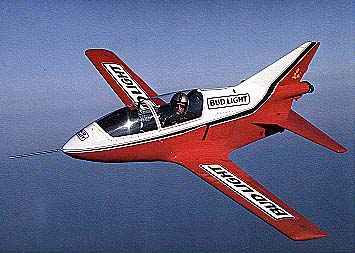 High flying bombers and transports will stand no
chance if microjets soar up from below, like guided missiles that cannot be
fooled or jammed. Fighter escorts will have just seconds to attempt
to engage a microjet, which will prove difficult as their radar and infrared
signatures are minuscule. Microjets can also support ground troops by performing reconnaissance and chasing down
UAVs and
helicopters. Readers may recognize the
BD-5 was once flown by Agent 007, James Bond.
High flying bombers and transports will stand no
chance if microjets soar up from below, like guided missiles that cannot be
fooled or jammed. Fighter escorts will have just seconds to attempt
to engage a microjet, which will prove difficult as their radar and infrared
signatures are minuscule. Microjets can also support ground troops by performing reconnaissance and chasing down
UAVs and
helicopters. Readers may recognize the
BD-5 was once flown by Agent 007, James Bond.
Small helicopters present a similar threat at low levels, especially in urban areas as they fly among tall buildings and dart out to fire at aircraft with an automatic cannon or air-to-air missiles. These "cowboy" fighters will prove deadly to $100 million aircraft and tactics to defeat them are non-existent, other than attacking them on the ground after they land to refuel or rearm. A small nation can buy some 200 armed microjets and small helicopters for the cost of one advanced fighter. Future wars may see large aircraft, helicopters, UAVs, and even mighty fighter jets downed by tiny, agile aircraft flown by daring cowboys.
Air Defenses
The US Air Force perfected methods to destroy integrated Soviet air defense systems, however, new concepts change this equation. Ground-launched fighter UAVs and cowboy fighters are a serious threat, while new air defense systems may prove equally deadly. Radio communications can avoid jamming with the use of frequency hopping. So long as the sender and receiver radios are in sync, they rapidly hop to different frequencies. The latest air defense radar allows operators to switch among several different frequencies to avoid jamming. However, modern jammers, like those used aboard EA-18F aircraft, can jam multiple frequencies. As radar operators select new frequencies, the jammers detect and block, and continue to block previous frequencies to prevent switching back.
 Frequency hopping radar solves this problem by automatically jumping to a
different frequency each second. This is easy to synchronize with radar because the
sender and receiver are programmed by the same unit. Since electronic jammers lack
the power to jam all frequencies, they may be rendered obsolete. The
latest American EF-18G promises to jam frequency hopping radar
"faster", but does not work fast enough. This is not a new
idea since the US military has employed this method for at least 30 years.
The old Lockheed S-3A Viking had a Texas Instruments AN/APS-116 (APS=Airborne/Pulsed/Search)
multi-mode search radar with an "agile" mode, where the syncronizer/transmitter
units were synched to the receiver, and was advertised as incapable of
being jammed! Today's radar jammers perform defensive jamming
against existing threat bands, not the entire defined RF spectrum!
Frequency hopping radar solves this problem by automatically jumping to a
different frequency each second. This is easy to synchronize with radar because the
sender and receiver are programmed by the same unit. Since electronic jammers lack
the power to jam all frequencies, they may be rendered obsolete. The
latest American EF-18G promises to jam frequency hopping radar
"faster", but does not work fast enough. This is not a new
idea since the US military has employed this method for at least 30 years.
The old Lockheed S-3A Viking had a Texas Instruments AN/APS-116 (APS=Airborne/Pulsed/Search)
multi-mode search radar with an "agile" mode, where the syncronizer/transmitter
units were synched to the receiver, and was advertised as incapable of
being jammed! Today's radar jammers perform defensive jamming
against existing threat bands, not the entire defined RF spectrum!
In addition, ground units can generate far more electrical power and thus mount far larger and more capable AESA radar systems than aircraft. So as high-power AESA or microwave systems appear on aircraft to fry electronics, they can be used for air defense as well. New types of mobile air defense systems will also prove deadly, like those using a Surface-to-Air Radar Aiming System that may fire Acoustic Missiles.
Airbase Defense
On November 1, 1964 the Viet Cong launched a "counter air" campaign and attacked the American air base at Bien Hoa with sappers and mortars killing four Americans, destroying five B-57 bombers and badly damaging eight others. The Marine airbase at Da Nang was hit on July 1, 1965 by a large sapper attack that destroyed three C-130s, three F-102s, and damaged three more F-102s. During the entire Vietnam conflict, 15 parked USAF C-130s were destroyed on the ground by the enemy. Most of these losses were caused by simple unguided rockets and mortars.
As the price of aircraft soar, airbase defense is more important than ever. A less advanced enemy may decide air combat with a modern air force is foolish, so it is best to attack airbases with missiles and commandos. Now that infantrymen have sophisticated guided missiles enemy commandos are a much greater threat to airbases. The threat from sappers is well-known and shoulder-fired Stinger missiles have emerged as a threat to aircraft taking off and landing at airbases. Modern Air Commandos can fire laser-guided mortars and Hellfire missiles from miles away to strike individual aircraft parked on a ramp. Even a man with a .50 caliber rifle can shoot up parked aircraft from two miles away.
Such weapons can be transported in cars or boats near an airbase. As a result, airbase defense must extend several miles around an airbase. Ideally, an airbase is located far from populated areas and roadways. Otherwise, roadways must be guarded to prevent someone from stopping and off-loading weaponry to attack the airbase. Waterways must be watched as well. If the airbase is near mountains, they must be patrolled to prevent enemy commandos from setting up on a mountaintop to shoot down aircraft.
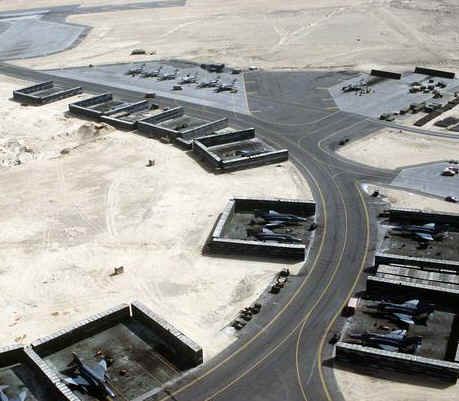 Of course the airbase perimeter must be guarded as well. On the night of
Sept. 14, 2012, 19 Taliban commandos raided the US airbase at Camp Bastion in
Afghanistan. They killed two Marines and destroyed eight AV-8B Harrier jet
attack aircraft. Airbase defense cannot be accomplished
by a few dozen security policemen in a war against a capable enemy. (Massive Camp Bastion
had just 100 contract security personnel.) A
major airbase needs an infantry battalion of personnel for security
duty. This seems like a lot of manpower, but serious protection 24/7
requires a battalion to allow one company on duty at all hours. Half of
this company will likely be on guard or patrol outside the airbase perimeter.
Much of the other half on duty to repel sappers can provide additional manpower
for vital tasks like building revetments. In the United States, this is an
ideal role for National Guard battalions.
Of course the airbase perimeter must be guarded as well. On the night of
Sept. 14, 2012, 19 Taliban commandos raided the US airbase at Camp Bastion in
Afghanistan. They killed two Marines and destroyed eight AV-8B Harrier jet
attack aircraft. Airbase defense cannot be accomplished
by a few dozen security policemen in a war against a capable enemy. (Massive Camp Bastion
had just 100 contract security personnel.) A
major airbase needs an infantry battalion of personnel for security
duty. This seems like a lot of manpower, but serious protection 24/7
requires a battalion to allow one company on duty at all hours. Half of
this company will likely be on guard or patrol outside the airbase perimeter.
Much of the other half on duty to repel sappers can provide additional manpower
for vital tasks like building revetments. In the United States, this is an
ideal role for National Guard battalions.
Perimeter security can be greatly enhanced with modern technology. Motion detectors are cheap and should be layered about the perimeter; dogs are excellent as well. Any high ground near the base where weaponry can be fired from must be patrolled to prevent long-range attacks. Unless aircraft make difficult spiral take-offs and landings, the ends of the runways must be guarded out over four miles. Light armored vehicles are needed to immediately assault attacking commandos. Finally, air commandos must be trained by modern air forces for both offensive and defensive operations.
The Future of Air Warfare is Uncertain
The future of air warfare will change dramatically. There is an assumption that modern air forces can easily achieve dominance over ground forces. This thinking arose because of easy success the sophisticated US Air Force has achieved in recent years. However, Iraqi air defenses really didn't exist during the 2003 invasion. During the 1999 air war against the second-rate Yugoslav military, their air defenses remained hidden, ready to repel a ground invasion that never came. This was demonstrated the day after the ceasefire when 14 Yugoslav MIG-29s appeared and flew in formation over Yugoslavia.
The 1991 air war against Iraq was highly successful, but again, Iraq had a second-rate military with older equipment and poor training. In addition, the French and Russians provided the US Air Force with detailed information about the Iraqi air defense systems they had sold and installed. In addition, the US Air Force had access to new, modern secure airbases and months to prepare to attack at their choosing. The US Air Force has not encountered modern air defense systems that have been sold worldwide over the past decade. Finally, the US Air Force is focused on continued improvements to its traditional method of fighting, and may be outclassed by an enemy employing innovations described in this book. A day may soon arrive when air defenses become too deadly to achieve air superiority against a modern military force.
©2015 www.G2mil.com